What is Windows 10 19H2 called?
Important as this release it, and nearer as we get, Microsoft still has not confirmed what it plans to call this feature update. The world has been going by with the codename 19H2, but it is also known as Windows 10 version 1909.
Denoting the year and month this update was signed off.
The big question is whether Microsoft will officially label this Windows 10 November 2019 Update. There remains a possibility that the company might avoid that particular name, given the past history of the previous fall update. The October 2018 Update was a downright calamity in terms of bugs and issues, many of which were only fixed months later.
It is also possible that, since this is practically a service pack, Redmond might decide to call it something else entirely and go in with a different naming scheme.
In any case, we will find out soon enough.
Windows 10 Build 10.0.18362.10005 Changelog:
Build 18362.10005 was the 2nd Insider Preview build of Windows 10 released after 19H1 build. It was released on July 15, 2019. This new build arrived via new “19H2” development branch.
- Windows containers require matched host and container version. This restricts customers and limits Windows containers from supporting mixed-version container pod scenarios. This update includes 5 fixes to address this and allow the host to run down-level containers on up-level for process (Argon) isolation.
- A fix to allow OEMs to reduce the inking latency based on the hardware capabilities of their devices rather than being stuck with latency selected on typical hardware configuration by the OS.
- Key-rolling or Key-rotation feature enables secure rolling of Recovery passwords on MDM managed AAD devices upon on demand request from Microsoft Intune/MDM tools or upon every time recovery password is used to unlock the BitLocker protected drive. This feature will help prevent accidental recovery password disclosure as part of manual BitLocker drive unlock by users.
- A change to enable third-party digital assistants to voice activate above the Lock screen.
Please note that the above mentioned changes and improvements were OFF i.e. disabled by default in this build.
Price and release date
Image used with permission by copyright holder
With the Windows 10 November 2019 Update, Microsoft to the way that major updates to Windows are delivered and installed. If your PC is running the May 2019 Update, 19H2 will not be delivered through Windows Update as a full-on “new” operating system as it has before.
To ensure a quality Windows experience, the Windows 10 November 2019 update is instead dedicated to “servicing” the existing Windows 10 May 2019 Update. This is akin to the “Service Packs” from the Windows XP and Windows 7 era.
If your PC is running the May 2019 Update, the November 2019 Update will appear in Windows Update as a regular servicing update. When ready, you will see it under an Optional updates available section. You can then install it when you’re ready by clicking download and install now.
In non-technical terms, this update will install on your computer just like a standard Windows 10 security patch. The wait time between installing will be shorter, and so will the download size.
According to Microsoft, only if you’re on an older version of Windows that pre-dates the May 2019 Update will you see and download it as a “new” release through Windows Update — just as it has worked the past.
As always, the update will be free and will be delivered to your PC via Windows Update for no additional cost. You’ll have the choice to download or install it. Only if your PC is on an older version of Windows 10 that is closer to the end of support will it be installed automatically.
Windows 10 Build 10.0.18362.10012 Changelog:
Build 18362.10012 was the 4th Insider Preview build of Windows 10 released after 19H1 build. It was released on August 08, 2019. This new build arrived via new “19H2” development branch.
- You can now quickly create an event straight from the Calendar fly-out on the Taskbar. Just click on the date and time at the lower right corner of the Taskbar to open the Calendar fly-out and pick your desired date and start typing in the text box. You’ll now see inline options to set a time and location.
- The navigation pane on the Start menu now expands when you hover over it with your mouse to better inform where clicking goes.
- Addition of friendly images to show what is meant by “banner” and “Action Center” when adjusting the notifications on apps in order to make these settings more approachable and understandable.
- Notifications settings under Settings -> System -> Notifications will now default to sorting notification senders by most recently shown notification, rather than sender name. This makes it easier to find and configure frequent and recent senders. A new setting is also available to turn off playing sound when notifications appear.
- Options to configure and turn off notifications from an app/website are also shown right on the notification, both as a banner and in Action Center.
- Addition of a “Manage notifications” button to the top of Action Center that launches the main “Notifications & actions” Settings page.
- Addition of additional debugging capabilities for newer Intel processors. This is only relevant for hardware manufacturers.
- General battery life and power efficiency improvements for PCs with certain processors.
- A CPU may have multiple “favored” cores (logical processors of the highest available scheduling class). To provide better performance and reliability, a rotation policy has been implemented that distributes work more fairly among these favored cores.
Please note that Windows Insiders who were on 19H2 build 18362.10005, received this build with features turned OFF i.e. disabled by default.
File Explorer integrates with Windows Search
In the early days of Windows 10, files stored on OneDrive were considered separate from files stored on your PC. Later, Microsoft allowed file syncing between your PC and OneDrive—first with actual files, then as Files on Demand “placeholders” that won’t take up any additional space on a local drive. Search has historically bridged the gap between the cloud and your PC; even on older versions of Windows, searching “This PC” collectively searches files stored in your OneDrive cloud as well as on your PC.
Poring though all those files, though, takes time. The Windows 10 November 2019 Update speeds that up somewhat. Because Windows Search now indexes your PC, the act of typing a file name within File Explorer should instantly bring up a list of search-engine-like suggested results, such as the “Lenovo” suggestions that began appearing as I typed “Len.” Those suggestions instantly load the file they link to.
Windows appears to prioritize recent searches to populate the list, which is useful. And you could argue that search performance has increased as a result, because the “instant” search results are indeed instantaneous. Unfortunately, only certain results are cached, and Windows still had to perform a full search of my PC (and OneDrive) on a file it didn’t have handy—which took as excruciatingly long as usual. This may improve over time. For now, however, the new File Explorer search experience is useful under certain scenarios.
Manage events in the Calendar and improved ways to manage notifications
Previous
Next
1 of 2
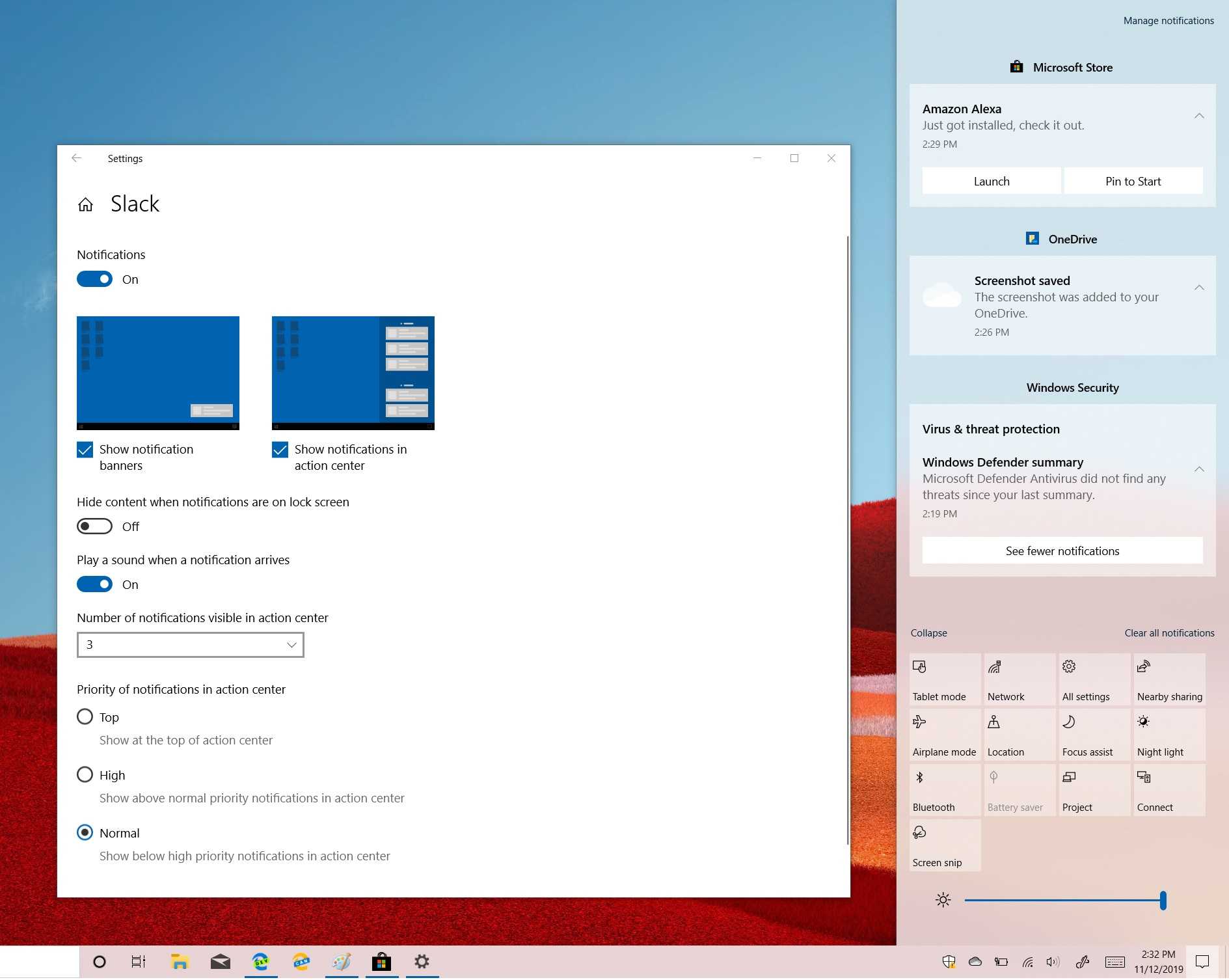 Arif Bacchus/Digital Trends
Arif Bacchus/Digital Trends
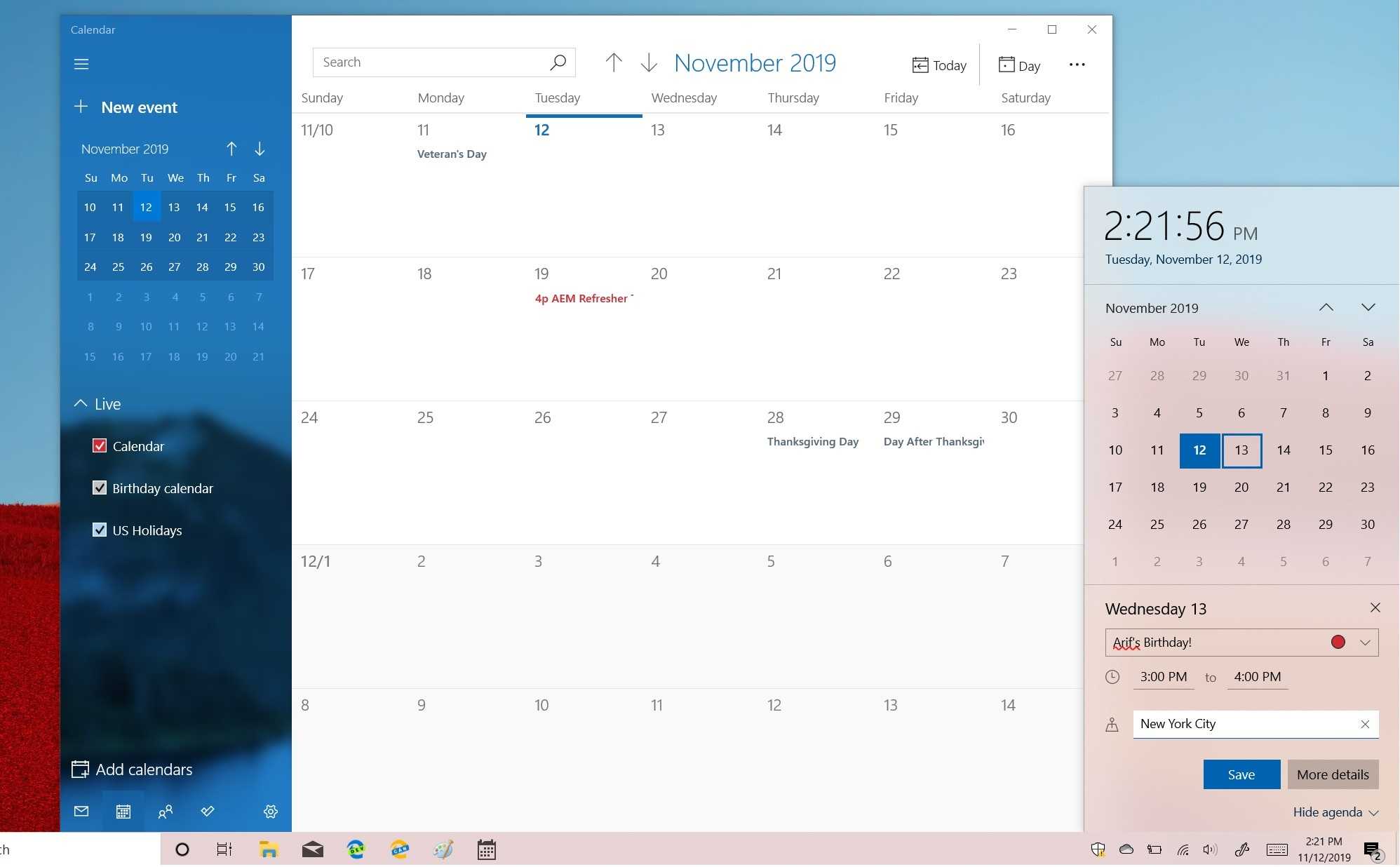 Arif Bacchus/Digital Trends
Arif Bacchus/Digital Trends
A second change in the Windows 10 November 2019 Update is an ability to manage and create events from the Calendar in the Windows 10 Taskbar. Now, clicking on a date in the calendar in the taskbar will give you flyout options to select a date and create a new event for that day. A new form will show up, and allow you to include the time, location for such events. You also can click More Details to open the Windows 10 calendar app.
This also ties in with the third major change to the ways to manage notifications. A new Manage Notifications option now shows up in the Action Center in the Windows 10 November 2019 Update. It redirects you to the notification settings option in Windows 10, where you can now see a per-app basis for the visual cues for what the different Windows 10 notification types look like.
Комментарии
Uleaned +315
Не в сети
Кто бы сомневался. Ну не может MS выпустить апдейт без багов.
29.11.19 12:44
-1
a666s +98
Не в сети
Да-да, цэ зрада. Вот если бы они тоже нифига не делали, то не было бы ни десятки, ни багов. И это была бы перемога.
29.11.19 17:07
+2
Uleaned +315
Не в сети
Понятие «контроль качества» вам ново, всё ясно.
29.11.19 18:34
-1
experemintator +229
Не в сети
Лично отправил 8 баг репортов о проблемах в обновлении 1909. Обещали до конца года рассмотреть и решить часть из них.
29.11.19 20:44
+2
a666s +98
Не в сети
Ничего абсолютно не зная о человеке уже сделали вывод. Это про Вас всё ясно. Хотя чего ожидать. В отличие от Майкрософта из достижений один безвиз.
29.11.19 22:07
asd62 +347
Не в сети
А причём тут это?
Давайте всё-таки о проблемах обновлений. Как таковые они свойственны всем ОС, включая мобильные, да и в программном обеспечении всевозможных приблуд, в котором оно в какие-то сотни мегабайт, и то его хватает. Так что без багов не обходится никто, от слова совсем. Здесь главным критерием должно выступать, на мой взгляд, оперативность устранения выявленных багов.
30.11.19 21:41
+5
a666s +98
Не в сети
Совершенно с Вами согласен. Просто уже надоело в шишки, что обязательно найдётся тот, кто пнёт Майкрософт с его системой. Всё в мире забаговано. Все андроиды, мак оси, линуксы. Все разработчики работают, развивают свои проекты, допускают при этом ошибки и устраняют их как могут. Но обязательно найдётся кто-то ангажированный, который подленько выделит именно Майкрософт и укусит. Это разве было по делу? Это обычное гонево в модном стиле что «винда отстой». Я думал что это у прыщавых мальков культивируется, а здесь на серьёзном ресурсе по идее взрослые дядьки.
Ну а проблемы… У меня пока только одна. На одной из машин до сих пор висит объявление, что система к 1909 не совсем готова, но как только всё будет совместимо будет обновлено. Это несколько странно, учитывая что и обновлять то практически нечего. Функционала то нет нового. На трёх других, которые дома, всё в порядке. Проблем видимых не обнаружено пока.
01.12.19 12:44
+3
Singularity +66
Не в сети
Тебе майки платят, чтобы ты их оправдывал?
02.12.19 11:13
-3
a666s +98
Не в сети
1. Нет. Ни майки, ни кеды, ни даже трусы мне не платят.
2. Вам кто-то платит чтобы спросить кто мне платит?
3. Не напомните когда это мы пили на брудершафт и перешли на ты?
02.12.19 13:40
+2
asd62 +347
Не в сети
Singularity и a666s ребята, давайте жить дружно. На данном историческом этапе мы все буржинские, за исключением тех, кто из Китая, но полагаю таковых среди нас нет.
02.12.19 13:51
+1
Windows 10’s File Explorer
Source: Windows Central (Image credit: Source: Windows Central)
The File Explorer app inside Windows 10 has also received a notable change; Windows Search now powers its search bar. This is the same thing that powers the search bar on the taskbar and allows you to search not only a local directory but files stored in your OneDrive as well. The UI is a bit cleaner, with a slightly larger search and address bar to match.
Microsoft is trying to make all search bar’s inside Windows 10 do the same thing. You shouldn’t have to think about which search bar does what when looking for files, photos, and documents. With the November 2019 Update, File Explorer’s search bar is now capable of looking for the same files that the search bar on the taskbar can, and vice versa.
Windows 10 v1909 new features
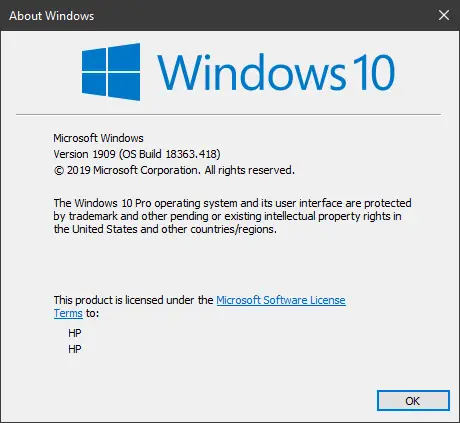
One of the best parts of this update is that unlike October 2018 update, this feature has been thoroughly tested in the Release Preview ring. That gave it a long time to get tested. Let’s check out the new features in Windows 10 v1909.
- Create Calendar events right from the taskbar
- Improved Notification Configuration
- File Explorer integrates with Windows Search
- Lock Screen and Third-party digital assistant integration
- Windows 10 can favor the faster cores in your processor
- Other small and under the hood improvements
- Narrator & Fn Keys
- Enterprise Changes.
Windows 10 v1909 is going to be an optional update. This means that you will get a notification about it, and you can choose to skip it. However, if your version of Windows 10 is nearing the end of the cycle, you will be updated to 1909.
1] Create Calendar events right from the taskbar
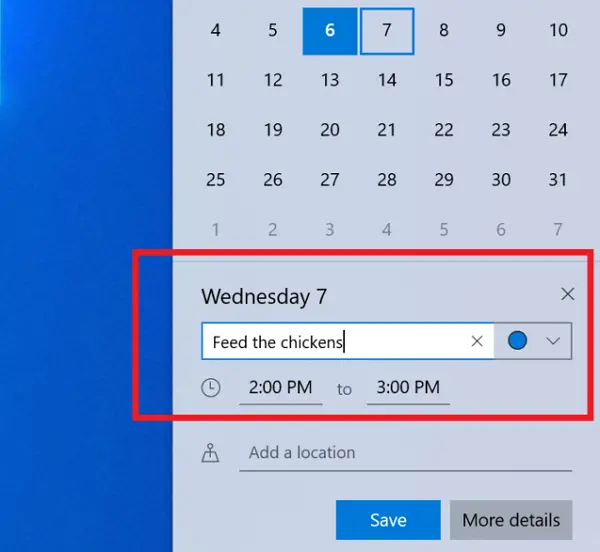
Finally, opening the calendar from the System tray is getting to some good use. You can quickly create an activity in your calendar from the Calendar flyout in the Taskbar.
- Double click on the date to open the Calendar
- Then select the date and time at the lower right corner
- Start typing in the text box, and you’ll now see inline options to set a time and location.
2] Improved Notification Configuration
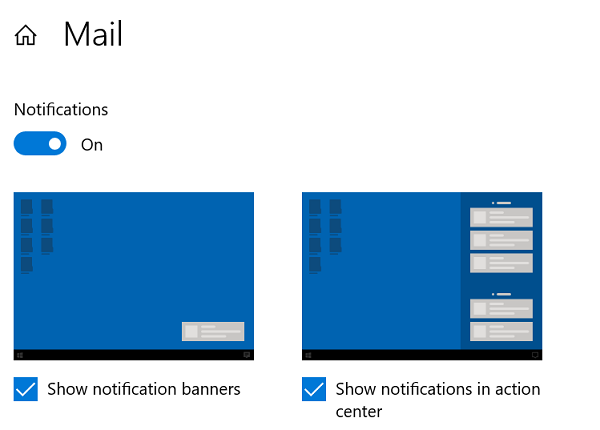
If there are too many notifications in your Action Center, and you are missing out on the important one, here is an improved visual in Windows 10 November 2019 updated. Windows Notification system lets you choose between banner and notification in the Action Center. The former pops as a standard notification fly-in at the corner. The later is the one which we usually see in the Action Center.
When configuring the options, you get a preview for both of them, and you can choose either both of one of the notification style.
If you hover on any of them, you can click on the small settings icon and turn off all the notifications you get from the sender. There is a Manage notifications link on top of the Action Center, which can take you to the Notifications and actions settings page directly.
Additionally, the notification are sorted by the most recent app instead of sorted by name. There is a setting available for that in the Notifications & actions page.
3] File Explorer integrates with Windows Search
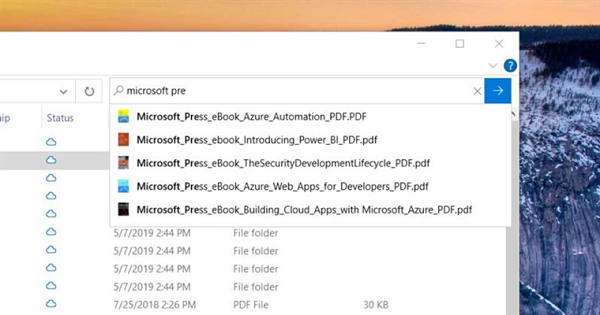
I am sure you know about File Indexing. It is separate from Windows Search. While Windows Search comes into action when you search on the taskbar, File Explorer is when you search using Explorer search box. Starting with Windows 1909, both of them are integrated. What’s the advantage?
According to Microsoft, it is faster, and can also show online content from your OneDrive cloud storage.
4] Lock Screen and Third-party digital assistant integration
Windows has API in place, which will let other digital assistants integrate with Windows Lock Screen. You will be able to invoke Alexa or Google Assistant, even when your PC is locked. As of now, Alexa works, but for Google, it might take some time to appear.
5] Windows 10 can favor the faster cores in your processor
There is not a lot of details available on how exactly it will work, but according to Microsoft, Windows can support the quicker cores in your processor. Processor are multi-cores, and if OEM has designed such that some cores are faster than others, then Windows will give them the tough job first.
As of now, AMD Ryzen processors have been optimized for it; In future, we should see the Intel processor also utilizing this. It is the primary reason why Microsoft claims that Windows 10 19H2 will deliver better battery life and power efficiency improvements for PCs with particular processors.
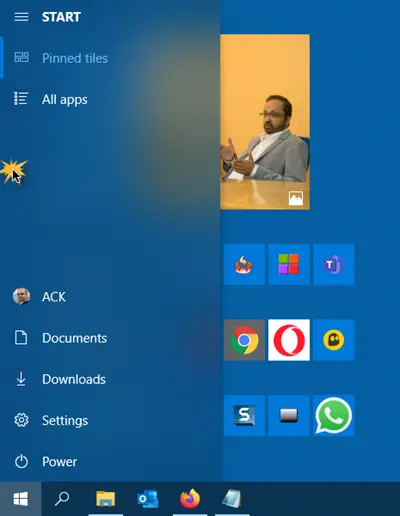
When you mouse hover on the left side of the Start Menu, the navigation pane from the Start Menu expands.
7] Narrator & Fn Keys
The narrator and other assistive technologies can read and learn where the FN key is on keyboards and whether it’s locked or unlocked
8] Enterprise Changes
Microsoft has listed down all the Enterprise changes here. Below is the gist of these changes:
- Windows containers require a matched host and container version.
- Key-rolling or Key-rotation feature enables secure rolling of Recovery passwords on MDM managed AAD devices. This feature will help prevent accidental recovery password disclosure as part of manual BitLocker drive unlock by users.
- They have enabled Windows Defender Credential Guard for ARM64 devices for additional protection against credential theft for enterprises deploying ARM64 devices in their organizations.
- Enterprise can supplement the Windows 10 in S Mode policy to allow traditional Win32 (desktop) apps from Microsoft Intune.
- Additional debugging capabilities for newer Intel processors.
These are the significant changes for Windows 10 v1909 November 2019 Feature Update. Let me know if missed something.
Windows 10 basic features
Microsoft, though introduces new features and sometimes removes old features from Windows 10, there are some core features that are the core part and became the identity of Win 10.
These features might vary in each version but we will have a look at them in general.
- Start menu: Windows 7 like start menu combined with modern apps.
- Cortana Assistant: a virtual assistant which recognizes voice commands.
- Microsoft Edge (web browser): an excellent browser with modern features.
- Task View: view and manage multiple tasks easily.
- Notification Center: all notifications appear here that need your attention.
- Settings: a dedicated control panel like environment to manage Windows.
- Windows 10 updates: get regular, feature, security and critical updates as soon as released.
- Supports desktop PC, laptops, tablets and phones.
- Open apps in full screen and normal window.
- Optimized UI for touch screen devices (without keyboard and mouse).
- DirectX 12: get maximum advantage of your hardware and feel the best graphics quality for games and video.
- Game bar: a dedicated set of controls to make your gaming experience more fun and useful.
Conclusion
The relatively light load of new features and additions, combined with simpler installation process means that 19H2 will probably land with a whisper and not a thud. But considering the bugs and stability issues Windows 10 has been struggling with lately, this is not a bad thing, altogether.
If you are consumer, there is not much to be excited about — this is not a big update. Business users and professionals may like the security and performance improvements a bit better.
All said and done, with the focus on the next major release in spring next year, in the form of 20H1, Microsoft has given the Windows team ample time to implement substantive new features in the platform. While hopefully, at the same time, also giving the user base a simple and stable refresh.
Game changer it may be not, but 19H2 certainly has changed the rules of the game!
Windows 10 Editions
Windows 10 has following major editions:
- Home
- Pro
- Enterprise
- Education
There are some other editions like Enterprise LTSC and a few others but these editions are not a part of regular release. Microsoft sometimes release these editions and sometimes skips them. Besides skipping, Microsoft can replace or terminate such editions. So users should focus on regular editions which are released with each version update and get latest updates regularly.
Microsoft has not released Windows 10 Ultimate edition just like Windows 7 Ultimate. It might never release because there was no ultimate edition released for Windows 8 as well.
Let’s have a look how each edition is different from others and which edition of Windows 10 is best for you.
Windows 10 Home
Home edition is the basic edition of Windows 10. It is suitable for normal computing. If you use your computer for general purposes and simple office works then you can use home edition. Don’t underestimate Home edition by its name because it is not that basic as you might consider. Unlike Windows 7 home editions, Windows 10 Home has more freedom and features. For example, one limitation of Home is that it supports only up to 128 GB RAM memory on 64-bit version. Seriously, this is 2019 and there is no 128 GB memory available in markets. Maximum 16 GB RAM is installed in best gaming computers.
Windows 10 Pro (Professional)
Professional edition is suitable for smart business and professional who use computer as an important part in their working environment such as photography, video editing, troubleshooting, virtualization etc.
Windows 10 Pro edition includes all features included in Home edition, plus following features:
- BitLocker
- Windows To Go
- Hyper-V
- Joining Windows domain
and more features useful for business.
64-bit version of Windows 10 Pro supports up to 2 TB RAM.
Windows 10 Enterprise
Enterprise edition is designed for large business, organizations and IT professionals. Overall, it has most features than all other editions. Though, it seems a great choice with maximum features, most of its features might be not practically usable by you or your company.
Windows 10 Enterprise edition is suitable for organizations who are either dealing in IT profession or has a dedicated team of IT professionals to manage complicated tasks. It is generally observed that Enterprise edition is not suitable for individuals and non-IT literate organizations.
You will need Microsoft Volume License to activate and use Enterprise edition.
Enterprise edition covers almost all features of Pro edition, plus the following features:
- AppLocker
- Device Guard
- DirectAccess
- Virtualization
- Microsoft Apps
and more features useful for business.
64-bit version of Windows 10 Enterprise supports up to 2 TB RAM.
Windows 10 Education
Education edition of Windows 10 is developed for academic institutes like schools, colleges, universities, libraries etc. Microsoft Academy Volume License is required to activate and use Windows 10 Education.
This edition has almost same features like Enterprise except some business level features. All features of Windows 10 Pro are covered in Education edition.
The Windows 19H2 story
Microsoft stirred things up a bit recently when it made the decision to split the major Windows 10 releases into two distinct flavors — the first one being a fully-fledged update with new features, and the other one being a secondary patch update.
Since we already go the first major update for the year as 19H1, this new release is now on the horizon.
What separates this release from the previous versions is how Microsoft plans to ship it to users. 19H2 will arrive in the form of a cumulative update that end users will be able to install on top of their current Windows 10 19H1 installation. This is a significant change for the company and should result in an overall smaller download and faster install process.
Speaking of changes, another notable change is that the 19H2 update is only being tested in the Slow Ring of the Windows Insider Program. That is because the Fast Ring of the preview program is paying host to the 20H1 release, which is well in development now.
This fall release of Windows 10 also gets you a full 30 months of support.
So, the big takeaways are that this next feature update for Windows 10 is actually a scoped set of select performance improvements, refinements and quality enhancements, with a handful enterprise features thrown in for good measure.
For Microsoft it is a big departure from the previous rushed strategy of two major updates a year. And going forward, the company will now focus on improving an update that already exists.
And for users, since 19H2 sits on top of the 19H1 release like a normal Windows 10 patch, there is less risk of errors and downtime when updating their devices to this new version. Which is all the more welcome considering the horror issues with the OS recently, and in particular with the previous fall release last year, which merits a mention.
Allowing third-party digital assistants to activate on the lock screen
One of the oddities accompanying the November 2019 Update has been the relative lack of documentation, or explanation, surrounding some of the features. Case in point: “A change to enable third-party digital assistants to voice activate above the Lock screen” is about all Microsoft has to say on the matter.
Recent news about a Voice Interoperability Initiative that includes Spotify, Orange, Amazon, Microsoft, and others suggests a future where several digital assistants could live on your PC—including the lock screen, which you can configure (Settings > Cortana > Talk to Cortana) to allow you to trigger Cortana by saying “Hey Cortana” while the lock screen is enabled. With Amazon’s Alexa now integrated within Cortana, enabling Alexa from the lock screen should work, right?
Nope—or at least, not yet. Using the “Alexa” wake word didn’t work on my test machine, and asking Cortana to enable Alexa (“Cortana, launch Alexa”) prompted Cortana to tell me to unlock my PC first. (“Cortana, launch Alexa” is the current way to open Alexa within Windows.)
Downloading the Alexa app and turning on hands-free Alexa capabilities allowed me to access Alexa when my Windows PC was awake and active, but Alexa’s wake word still refused to work from the lock screen. Unfortunately, multiple lock-screen wake words looks like a future capability that’s just not turned on yet.
How to Get Windows 10 version 1909 (November 2019) update?
There are three recommended ways to get November 2019 update:
- Download via Windows 10 Media Creation Tool
- Upgrade using Windows 10 Update Assistant Tool
- Download Windows 10 (version 1909) ISO (Bootable Disc Image)
Here is how to use each of these methods:
Download via Windows 10 Media Creation Tool
Microsoft has launched Media Creation Tool for Windows 10 download and upgrade. You can upgrade your existing Windows OS using upgrade option. It will save your existing Windows files to recover in future (if needed) and upgrade to latest version of Windows 10 while keeping your apps, documents and personal files at the same place and condition as those were before upgrade.
Alternatively, you can download latest ISO file or create bootable installation media of Windows 10 using Media Creation Tool. Downloading Windows 10 ISO file is more flexible option because you can save ISO file and use it in various ways; like mount ISO to upgrade Windows 10 or create bootable USB/DVD from ISO file using Rufus or your favorite Windows ISO to USB creator tool.
If you choose to directly create USB/DVD instead of downloading Windows ISO image file, you will need to insert a USB with at least 8 GB storage capacity. Don’t forget to backup USB data before you start creating Windows 10 installation media creation process because all data on USB flash drive will erase.
Upgrade using Windows 10 Update Assistant Tool
Windows 10 Update Assistant (also known as Windows 10 Upgrade Assistant) is best tool if you want to upgrade to Windows 10 latest version. This tool requires internet connection till the upgrade process is finished. The upgrading will fail if internet connection is lost during downloading Windows 10 installation files.
Update Assistant is fantastic software to update as it guides you in a step by step installation wizard to finish in the simplest way. It has a few steps to make upgrading easy. Once the downloading process starts, you can minimize Windows 10 Update Assistant program and keep using Windows. The program will notify you when everything is ready and you will need to restart your computer.
Download Windows 10 (version 1909) ISO (Disc Images)
This is the best, easiest and most flexible method to get your desired version. You can use the ISO in different ways, like:
- Save ISO file for later use.
- Reuse ISO file for multiple computer.
- Create many USB/DVD installation media for Windows 10.
- Mount ISO to upgrade Windows 10 as fast as possible.
You can use Media Creation Tool to download Windows 10 ISO file but that requires you an extra step of downloading Media Creation Tool first. Downloading may fail and restart from beginning if internet connection is lost. On the other hand, you can download latest version of Windows 10 ISO from Windowstan. Links are given below:
Download Windows 10 ISO (Full Version)
All 4 editions of Windows 10 are here. Select your favorite edition.
Note: Following links will take you to the latest version of Windows 10 (instead of the version listed in this post).
| Windows 10 Home | Free download Windows 10 Home ISO |
| Windows 10 Pro | Free download Windows 10 Pro ISO |
| Windows 10 Enterprise | Free download Windows 10 Enterprise ISO |
| Windows 10 Education | Free download Windows 10 Education ISO |




![Download windows 10 november 2019 update (version 1909) iso images [all languages]](http://jsk-oren.ru/wp-content/uploads/3/2/4/3243fbfd75f5795464264f06f8872ed3.jpeg)

![Windows server, version 1909 (10.0.18363.592) - оригинальные образы от microsoft msdn [en/ru] (2020) скачать торрент бесплатно](http://jsk-oren.ru/wp-content/uploads/a/a/7/aa79205fce00f1871d7df3ca05d84fb4.jpeg)













![[changelog] what’s new in windows 10 november 2019 update (version 1909) – askvg](http://jsk-oren.ru/wp-content/uploads/b/2/1/b212e403c9851c7296be7439120fbf58.jpeg)



![Download windows 10 november 2019 update (version 1909) iso images [all languages]](http://jsk-oren.ru/wp-content/uploads/e/a/1/ea19067ee290e987c86da5efe223eb0a.jpeg)



![Windows server, version 1909 (10.0.18363.592) – оригинальные образы от microsoft msdn [en/ru] скачать торрент](http://jsk-oren.ru/wp-content/uploads/d/6/8/d683f8a919979b23eac4b3b2722ea882.png)